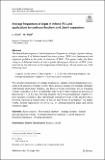Average frequencies of digits in infinite IFS’s and applications to continued fractions and Lüroth expansions
Abstract
The detailed investigation of the distribution of frequencies of digits of points belonging to attractors K of Infinite iterated functions systems (IIFS’s) is a fundamental and important problem in the study of attractors of IIFS’s. This paper studies the Baire category of different families of sets of points belonging to attractors of IIFS’s characterised by the behaviour of the frequencies of their digits. All our results are of the following form: a typical (in the sense of Baire) point x ∈ K has the following property: the average frequencies of digits of x have maximal oscillation. We consider general types of average frequencies, namely, average frequencies associated with general averaging systems. These averages include, for example, all higher order Hölder and Cesaro averages, and Riesz averages. Surprising, for all averaging systems (regardless of how powerful they are) we prove that a typical (in the sense of Baire) point x∈K has the following property: the average frequencies of digits of x have maximal oscillation. This substantially extends previous results and provides a powerful topological manifestation of the fact that “points of divergence” are highly visible. Several applications are given, e.g. to continued fraction digits and Lüroth expansion digits.
Citation
Olsen , L & West , M 2020 , ' Average frequencies of digits in infinite IFS’s and applications to continued fractions and Lüroth expansions ' , Monatshefte für Mathematik , vol. First Online . https://doi.org/10.1007/s00605-020-01457-w
Publication
Monatshefte für Mathematik
Status
Peer reviewed
ISSN
0026-9255Type
Journal article
Collections
Items in the St Andrews Research Repository are protected by copyright, with all rights reserved, unless otherwise indicated.

